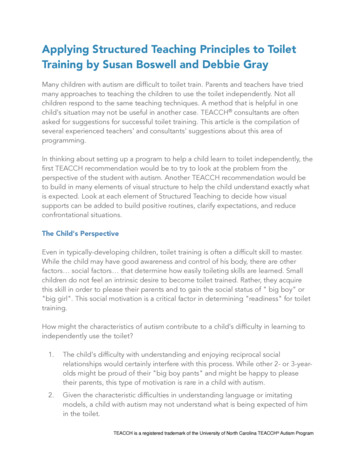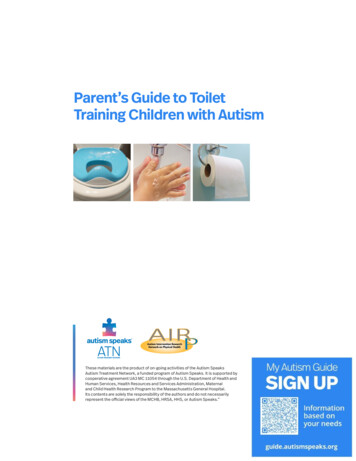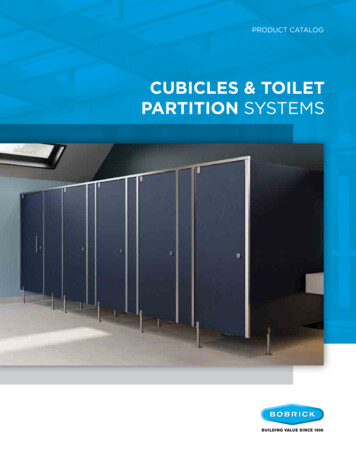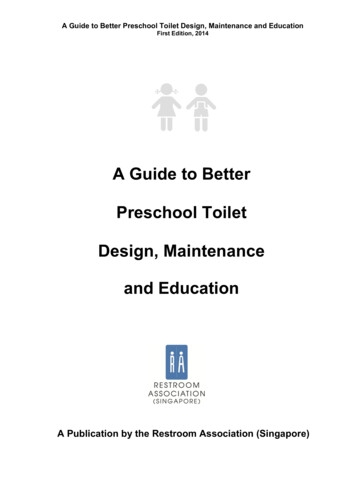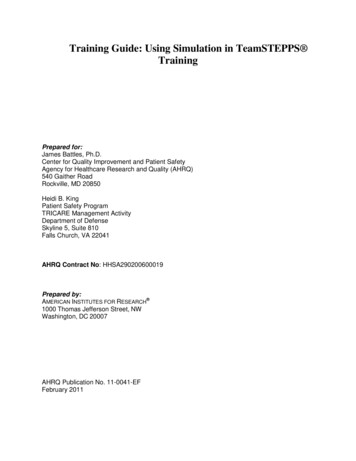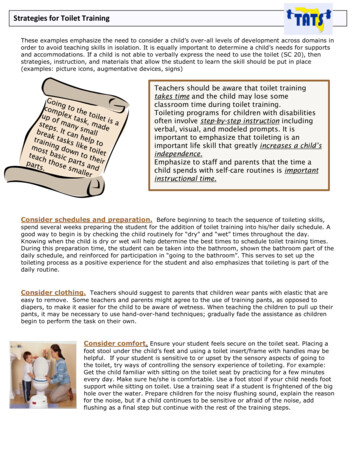
Transcription
Strategies for Toilet TrainingThese examples emphasize the need to consider a child’s over-all levels of development across domains inorder to avoid teaching skills in isolation. It is equally important to determine a child’s needs for supportsand accommodations. If a child is not able to verbally express the need to use the toilet (SC 20), thenstrategies, instruction, and materials that allow the student to learn the skill should be put in place(examples: picture icons, augmentative devices, signs)Teachers should be aware that toilet trainingtakes time and the child may lose someclassroom time during toilet training.Toileting programs for children with disabilitiesoften involve step-by-step instruction includingverbal, visual, and modeled prompts. It isimportant to emphasize that toileting is animportant life skill that greatly increases a child’sindependence.Emphasize to staff and parents that the time achild spends with self-care routines is importantinstructional time.Consider schedules and preparation. Before beginning to teach the sequence of toileting skills,spend several weeks preparing the student for the addition of toilet training into his/her daily schedule. Agood way to begin is by checking the child routinely for “dry” and “wet” times throughout the day.Knowing when the child is dry or wet will help determine the best times to schedule toilet training times.During this preparation time, the student can be taken into the bathroom, shown the bathroom part of thedaily schedule, and reinforced for participation in “going to the bathroom”. This serves to set up thetoileting process as a positive experience for the student and also emphasizes that toileting is part of thedaily routine.Consider clothing. Teachers should suggest to parents that children wear pants with elastic that areeasy to remove. Some teachers and parents might agree to the use of training pants, as opposed todiapers, to make it easier for the child to be aware of wetness. When teaching the children to pull up theirpants, it may be necessary to use hand-over-hand techniques; gradually fade the assistance as childrenbegin to perform the task on their own.Consider comfort. Ensure your student feels secure on the toilet seat. Placing afoot stool under the child’s feet and using a toilet insert/frame with handles may behelpful. If your student is sensitive to or upset by the sensory aspects of going tothe toilet, try ways of controlling the sensory experience of toileting. For example:Get the child familiar with sitting on the toilet seat by practicing for a few minutesevery day. Make sure he/she is comfortable. Use a foot stool if your child needs footsupport while sitting on toilet. Use a training seat if a student is frightened of the bighole over the water. Prepare children for the noisy flushing sound, explain the reasonfor the noise, but if a child continues to be sensitive or afraid of the noise, addflushing as a final step but continue with the rest of the training steps.
Positive Reinforcement is vital. Rewards should be used judiciously. When the childhas a toileting success, affirm him by smiling, clapping, and praising. You also can providetreats. The ultimate reward for the child is staying comfortable and dry, and the child shouldbe praised for staying dry. Give specific and positive feedback for each step in the toiletingprocess achieved.Use a timer to cue students that it is time to go to the potty. When the timer goes off, you will takeyour child to the bathroom and say: “Time to go to the bathroom”. When the timer goes off again, tellhim/her: “Time to go to the bathroom”. Increase the amount of time between setting the timer as yourchild remains dry for longer periods of time.Use specific language. For example, say, ‘Eddie, sit on the toilet so you can have a wee’. This isclearer than asking your child to ‘sit on the toilet’, and will help your child understand what to do. Chooseone word to refer to going to the toilet. Get everyone in the family to use it. For example, always say‘toilet’ or whatever your family is comfortable with. Teach the student a way of letting teachers andparents know she needs to go to the toilet. This could include nonverbal signing or the use of a picture orverbalized words.Provide classroom support by including a doll that can wet andset a schedule so that a child can take the doll to toilet. Have a “pottyparty”, clap, and say “hooray” when the doll “goes potty.” Providechildren’s books that focus on potty training. Make a social story bookspecific to the student who is having difficulty with potty training.Children’s Books for the ClassroomBelow are listed some children’s books about using thetoilet. Books about toileting should be available in theclassroom library and can also be read to small groupsor individual children.List reference: Parents’ MagazinePotty by Leslis PatricelliThe Silly Potty Story by Vanessa RouseOnce Upon a Potty: Girl and Once Upon a Potty:Boy by Alona FrankelHow to Potty Train Your Monster by Kelly DiPucchioBig Boy Potty and Big Girl Potty by Mary LeeThe Boss of the Potty by Henry AabbThe New Potty by Gina MayerDinosaur vs. the Potty by Bob SheaPotty Superhero by Parragon BooksP is for Potty by Sesame Street Books
Use a visual schedule that outlines the steps in the toileting process. Story based interventions andvideo modelling can also help children understand the toileting process. Positively reinforce toiletingsuccess with rewards. This can be done by adding a picture of the reward to the end of the toiletingsequence. Go over the schedule with the child 2-3 times a day or more often depending on the toiletingschedule. Everyone who does toileting with students will need to know and follow the routine. This way,training will be consistent.Social Scripts with Visual Supports are useful in describing the toileting process to the student.When writing a social script, use words and pictures that are appropriate for the student’s developmentallevel and personalize the story. The story should be read to the student several times a day in preparationfor the toileting lesson. The social script does not take the place of the visual schedule.Example of a simple visualschedule for toiletingExample of a detailed visual schedule for toiletingwith a chart for rewards includedNote: “Social Story” is a copyrighted term. The methoddeveloped by Carol Gray for writing social stories uses fivesentences which present a situation, suggest actions, andprovide a positive outcome. Social stories should bepersonalized and can include photos. It is recommended that astory be read to a child several times a day and that it be readin preparation and not during the activity.Example of a Social Script for ToiletingSometimes my body lets me know that I need to “use the bathroom”.When this happens I can go into the bathroom and use the toilet.I can sit on the toilet and “go” into the toilet.When I’m finished I can flush the toilet, wash my hands, and return to what Iwas doing.When I “go” in the toilet, my underwear does not get wet or dirty.My parents and teachers are proud of me when I go to the bathroom.
Prompting Students during the Toileting RoutineChildren who are not potty trained are likely to require prompting from adults in order to establishand participate in a toileting routine at school. Some children who have been successful with pottytraining at home might show some regression in toileting skills when they start school. It isimportant to provide prompts throughout the routine until it successfully established in the dailyschedule. A brief description of prompt hierarchy (least to most) is listed below: Verbal prompt – State to the child: “Time for bathroom; walk to the bathroom.” Visual prompt – Show the child a picture of the bathroom symbol. Modeling and Gesturing – Point toward the bathroom.o Note: the three prompts listed above can be combined so that the adult shows thepicture and makes the verbal direction at nearly the same time.o The picture icons used for prompting should be the same as those on the child’sclassroom or individual schedule. Physical assistance – hand-over-hand helpo Partial physical assistance to get the student started – Take the child’s hand or use agentle touch at the shoulder or elbow to begin to guide him/her toward the bathroom.o Full physical assistance throughout the entire step of the task. If needed, hold thechild’s hand until you reach the bathroom.Some important aspects of using prompts are as follows: Analyze the skill so that you know the steps of the task you are teaching your students.o Consider the abilities of the child to perform the motor skills required to perform thetask. For example, be aware of difficulties in fine motor skills and/or hand and fingerstrength and coordination required for initiating the step of pulling down pants. Don’t forget the importance of positive reinforcement. Use various words, phrases, actions,and tangible rewards so that the child does not become tired of or satiated with any onereinforcement strategy. Remember to use “Wait Time”. This is difficult to do sometimes, but it is necessary fordeveloping independence. After a prompt is given – Wait – in order to give the child time toprocess the step of the task. Observe carefully so that you don’t help too soon. Fade prompts as appropriate but don’t fade so quickly that you cause frustration. Make thereinforcement for independent participation more exciting than reinforcement for hand-overhand participation. Keep the focus on increasing the child’s participation.It is especially important to provide opportunities for students with significant delay and significantphysical disabilities opportunities to participate as much as they are able. Even if a student isunable to walk to the bathroom, he/she should be given opportunities to point toward, look toward,or communicate in some way that it is time to go to the bathroom. Students who are unable toinitiate physical steps of toileting should be given opportunities to participate in such ways aspointing to or asking for their personal items in the bathroom or participate by holding/handing theadult needed items.
References:Aponte, Courtney and Mruzek, Daniel. Seven toilet training tips that help nonverbal kids with autism.University of Rochester Medical Center, dricks, Dawn. Using prompts to promote skill acquisition. Virginia Commonwealth University AutismCenter for Excellence. http://www.vcuautismcenter.orgHow to Write a Social Story: Tips and Resources for Teachers. Vanderbilt Kennedy Center, Nashville, heets/socialstoriestips.pdfRaising Children Network: Toilet Training for children with autism spectrum ism spectrum disorder toilet training.htmlInge, Katherine. Using a least to most prompt teaching strategy. Virginia Commonwealth UniversityAutism Center for Excellence. http://www.vcuautismcenter.orgWheeler, Maria. Toilet Training for Individuals with Autism and Other Developmental Issues, SecondEdition. Future Horizons, 2007.
Use a visual schedule that outlines the steps in the toileting process. Story based interventions and video modelling can also help children understand the toileting process. Positively reinforce toileting success with rewards. This can be done by adding a picture of the reward to the end of the toileting sequence. Go over the schedule with the child 2-3 times a day or more often depending on the toileting
